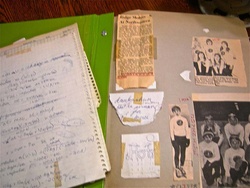In her book, Best Friends Forever: A World War II Scrapbook, writer Beverly Patt uses a unique format—a scrapbook—to tell the story of the friendship between two young girls separated during World War II. After her Japanese American friend, Dottie Masuoka, and her family have been sent to “Camp Harmony” following the bombing of Pearl Harbor, fourteen-year-old Louise Krueger dedicates herself to keeping a journal that she will be able to share with her best friend when she returns. The items in the scrapbook—from newspaper clippings, to hair ribbons, to letters from Dottie—are beautifully illustrated within Best Friends Forever and are accompanied by both heartwarming and heartbreaking journal entries by Louise.
Although the book is fictional, the contents of the scrapbook are utterly believable, capturing realistic reactions to the prejudices and injustices endured by Japanese Americans during World War II. Additionally, although Louise Krueger is not forced into camps as her friend Dottie is, she herself is subjected to painful derision and racial slurs because of her friendship with Dottie and for her German ancestry. Expressing both the innocence and wisdom of childhood, she gives voice to the pain and confusion experienced by many Americans during that time.
According to an interview posted on Beverly Patt’s website, the idea for Best Friends Forever came from her mother who told stories from her childhood in California. Among these stories was one of a family who, according to her mother’s recollections, mysteriously disappeared. The memory of that story remained with Beverly Patt until years later when she heard an interview on NPR with a musician whose band had formed in one of the internment camps. The author suddenly made the connection that the disappearance of the family in her mother’s story was not a mystery; she realized they had been forced into internment camps. From that point on, Beverly Patt became determined to do what she could to spread the knowledge of this period in American history to younger generations.
In an interview for this article for the Japanese American National Museum, Beverly Patt discussed how Best Friends Forever developed from a magazine story into a book.
After sharing her idea for the story with friends, Patt was put in contact with a friend’s aunt and uncle who were willing to discuss their first-hand accounts of living in internment camps. With the details provided by the couple, Dave and Margaret Masuoka, Patt was able to capture the emotions and feelings of the character of Dottie Masuoka in a more realistic way. The author explained, “In writing, I would come up with questions–things I couldn’t find answers to in my research—so I would email these to the Masuokas. They wrote back very detailed answers, as well as sending pamphlets and booklets and all sorts of background material. They were amazing—I can’t tell you how much I relied on their first-hand knowledge and experience! After the magazine story was published, I wanted to do more, to expand the story to a book-length manuscript. So, I did more writing and came up with more questions! We corresponded for probably two years, back and forth.” Beverly Patt used the name, Masuoka, for her character as a kind of tribute to Dave and Margaret Masuoka for their generous contributions.
Despite the incredible details provided by the Masuokas and additional research sources, Beverly Patt still faced a number of unique challenges in creating Best Friends Forever because of its scrapbook format. Patt had to write the newspaper articles in the scrapbook; she also had to locate photos and receive permission to use them. In creating all of these items, she and her editor, Robin Benjamin, did a great deal of additional research to make sure that facts were correct and that even word choices were accurate for that period. It seems that everything, including Patt’s own personal scrapbook, became a potential source for the contents of Best Friends Forever. In fact, Louise’s Red Cross and confirmation certificates were actually pulled directly from one of the author’s childhood scrapbooks and integrated into the book. She credits graphic designer, Kirstin Branch, with adding Louise’s own information to the certificates and creating a sense of authenticity. “I think a lot of the success of this book will be due to her (Kirstin Branch)—it is so visually appealing and so REAL-feeling.”
After many revisions and several years of sending the manuscript to different publishers, Marshall Cavendish finally agreed publish the book. Now that others can read her story, Beverly Patt hopes that it will inspire as well as educate her readers. “My hope is that Best Friends Forever: A World War II Scrapbook will find its way into every classroom in America and will help to educate our young people and will stimulate discussions relating race, prejudice and what it means to be an American. My second hope is that my book does justice and honor to those Japanese Americans who experienced this forced internment first hand.” The author herself found the process of researching and writing the book to be an incredible learning experience. “I knew NOTHING about Japanese Internment and was appalled that I’d never been taught anything about it. Probably the most amazing thing I learned was the Japanese American’s attitude of ‘shikataganai’—it cannot be helped—and how they held their spirits up throughout this whole ordeal and well after.”
She credits her years of working with special needs students—children who had been taken from their homes due to abuse or neglect—as instilling her with a heartfelt connection to her subject. “Teaching the ‘last and the lost’ also gave me a heart for the underdog—those taken advantage of or treated unfairly—which the Japanese American population definitely was during World War II.”
Best Friends Forever recently received a starred review in School Library Journal and was named to the Alan County Mock Newbery list. Beverly Patt has also written, Haven, and is currently working on a modern-day novel about a boy whose band has gotten back together without him. In regard to a possible sequel to Best Friends Forever: A World War II Scrapbook, Patt responded, “I have an idea for a sequel to Best Friends Forever, but I don’t know if it will happen or not! One can always hope!”
* * *
Beverly Patt is scheduled to read from Best Friends Forever: A World War II Scrapbook at the Japanese American National Museum on Saturday, October 2, 2010 at 2:00 pm.
There will be a book signing after the program.
*All photos are courtesy of the author.
© 2010 Japanese American National Museum











